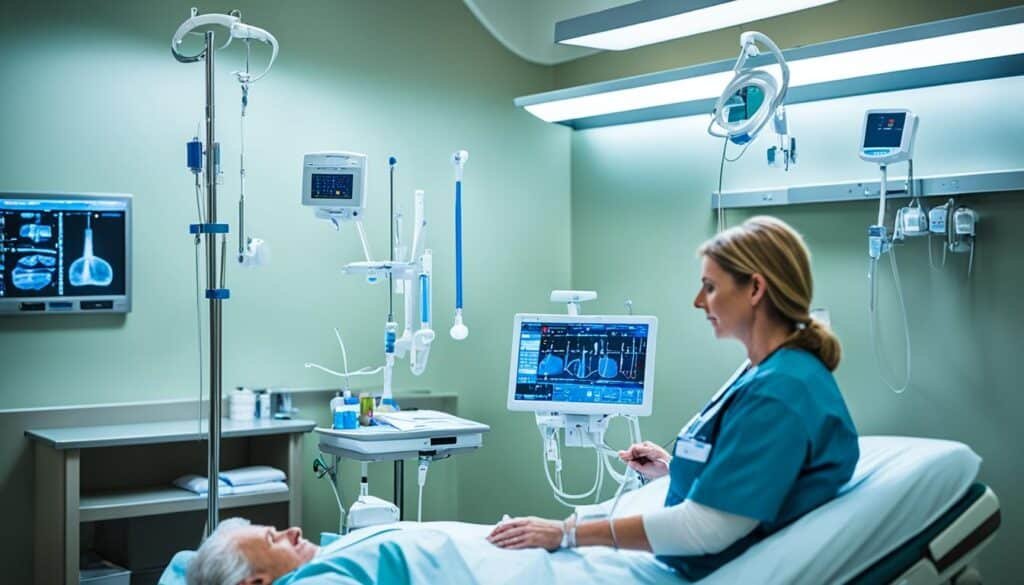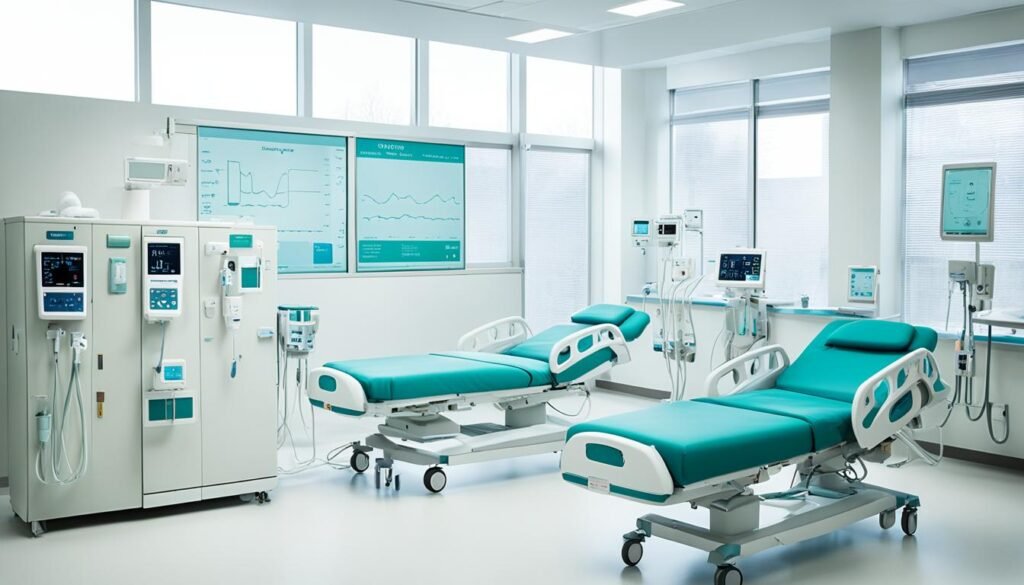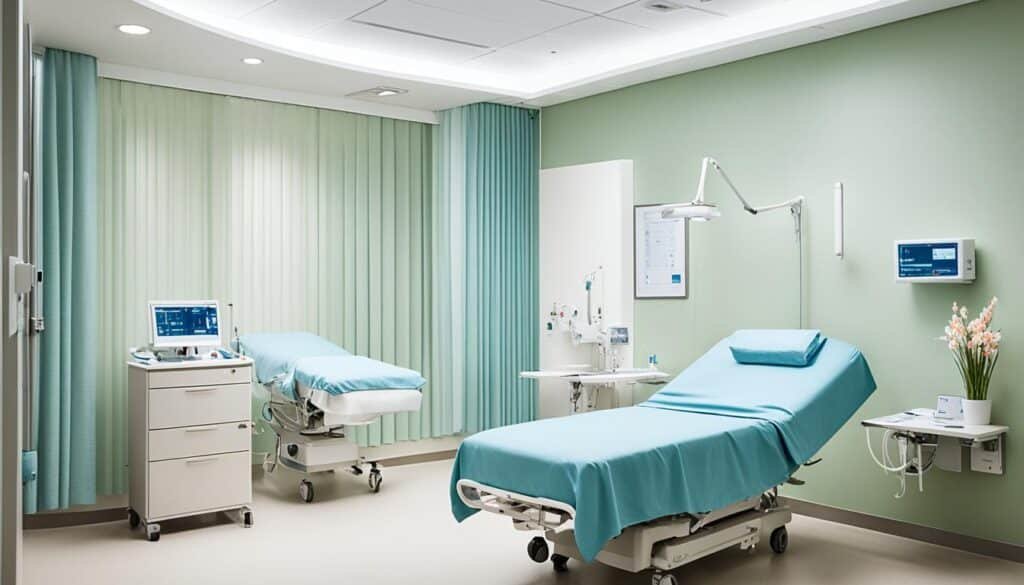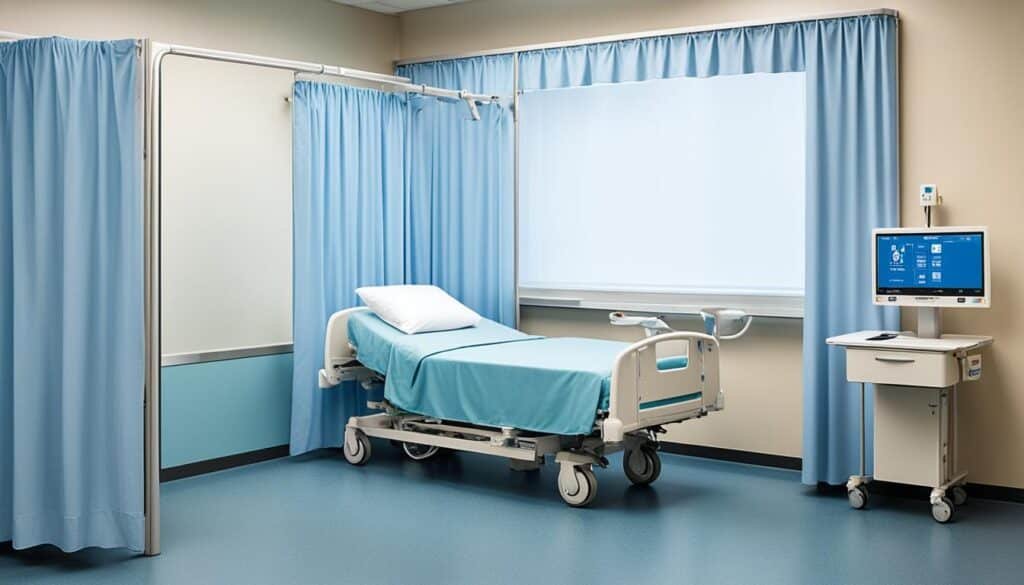Patients deserve a comfortable and pleasant hospital room experience to aid in their recovery and overall well-being. By prioritizing patient comfort, hospitals can improve patient satisfaction and ensure a positive perception of their care.
When patients are in the hospital, it is essential to provide them with the highest level of comfort and care. This not only contributes to their well-being but also plays a crucial role in their overall experience and satisfaction. In this article, we will explore various strategies that hospitals can implement to enhance the hospital room experience for patients.
Key Takeaways:
- Providing a comfortable hospital room can improve patient satisfaction and contribute to their overall well-being.
- Prioritizing patient comfort helps create a positive perception of the hospital’s care.
- Hospitals can enhance patient comfort by clear communication and explaining procedures to reduce anxiety.
- Regular room checks ensure that patient needs and concerns are addressed promptly.
- Maintaining optimal temperature and air quality in hospital rooms improves patient comfort.
Explaining Procedures to Ease Anxiety
One way to improve patient comfort and alleviate anxiety in a hospital setting is through clear communication and explanations of medical procedures. When patients receive comprehensive explanations about their diagnoses and treatment plans, it helps them understand the process and reduces uncertainty, ultimately promoting relaxation and a sense of control.
Clear communication allows patients to actively participate in their healthcare decisions and feel more engaged in their own care. By encouraging patients to ask questions and express their concerns, healthcare professionals create an environment that fosters trust and open dialogue.
“Understanding my procedure and what to expect made me feel less anxious. The doctor took the time to explain everything, which helped me feel more comfortable.” – Sarah Thompson, a former hospital patient.
Medical professionals can use various methods to explain procedures effectively:
- Using visual aids such as diagrams or videos to illustrate the procedure
- Breaking down complex medical terms into simpler language
- Sharing success stories and experiences of previous patients
By employing these strategies, healthcare providers can address patient anxiety proactively and create a supportive environment that caters to individual needs.
| Benefits of Clear Communication | Methods for Effective Communication |
|---|---|
|
|
Frequent Room Checks for Trust and Needs

One of the key elements in providing a comfortable hospital room experience is frequent room checks by hospital staff. These regular check-ins not only build trust between patients and healthcare providers but also ensure that patients’ needs are met promptly, contributing to their overall satisfaction and well-being.
By conducting regular hospital room checks, nurses can address any concerns or needs that patients may have. This proactive approach helps alleviate patient anxiety and fosters a sense of reassurance, knowing that they are being cared for attentively.
A crucial aspect of frequent hospital room checks is responding promptly to patient calls through call lights or intercom systems. When patients need assistance or have questions, being able to communicate with hospital staff promptly enhances their sense of comfort and security.
“Regular room checks provide patients with the confidence that their well-being is a top priority for the healthcare team.” – Dr. Emily Evans, Chief of Nursing.
| Benefits of Frequent Room Checks |
|---|
| 1. Builds trust between patients and healthcare providers |
| 2. Addresses patient needs and concerns promptly |
| 3. Reduces patient anxiety and promotes a sense of reassurance |
| 4. Enhances communication and responsiveness through call lights |
Through regular hospital room checks and prompt responsiveness to patient needs, healthcare providers facilitate a positive and supportive environment that fosters patient trust and comfort.
Maintaining Optimal Temperature and Air Quality

Ensuring a comfortable and soothing environment is vital for enhancing patient comfort and overall well-being in hospital rooms. One key aspect that significantly contributes to patient comfort is maintaining the optimal temperature and air quality.
The hospital room temperature plays a crucial role in promoting patient comfort. It is essential to monitor and regulate the temperature to create a pleasant and relaxing atmosphere for patients. Keeping the room temperature within a comfortable range helps patients feel at ease and aids in their recovery process.
In addition to temperature, air quality also plays a significant role in patient comfort. Poor air quality can lead to discomfort, exacerbate respiratory conditions, and impact overall well-being. Hospitals need to prioritize air circulation and filtration systems to ensure clean and fresh air for patients.
Patients with respiratory conditions or sensitivities are particularly vulnerable and may require extra attention to air quality. Adequate filtration and ventilation systems help minimize allergens, pollutants, and odors, creating a healthier environment for these patients.
“A comfortable environment, including optimal temperature and good air quality, is essential for patient well-being and satisfaction. It contributes to a positive hospital experience and aids in the healing process.” – Dr. James Thompson, Pulmonologist
Maintaining optimal temperature and air quality in hospital rooms is a multifaceted effort. Regular monitoring, maintenance of HVAC systems, and adherence to best practices in air quality control contribute to creating a comfortable environment for patients.
Tips for Maintaining Optimal Temperature and Air Quality:
- Regularly monitor and adjust the temperature within the recommended range for patient comfort.
- Ensure proper ventilation and air circulation by regularly cleaning and maintaining HVAC systems.
- Implement air filtration systems to remove allergens, pollutants, and odors.
- Consider using technologies such as HEPA filters to enhance air quality.
- Provide patients with control over room temperature, allowing them to adjust it according to their comfort level.
By prioritizing hospital room temperature and air quality, healthcare facilities can create a more conducive and comfortable environment for patients. Investing in these aspects significantly contributes to enhancing patient comfort, satisfaction, and overall well-being during their hospital stay.
Teaching Patients to Use Bed Adjustments

Hospital beds are equipped with various adjustable settings to enhance patient comfort and promote better recovery. However, many patients may not be familiar with how to properly utilize these bed adjustments to customize their comfort levels. By educating patients on the available bed adjustments and teaching them how to make necessary changes, hospitals can empower patients to take control of their own comfort and enhance their overall experience during their stay.
Providing patients with the knowledge and skills to adjust their beds according to their preferences can significantly improve their comfort and well-being. Patients who are able to find the most comfortable positions through bed adjustments may experience reduced pain and improved circulation, which can contribute to better rest and faster healing.
Here are some common bed adjustments that patients should be taught to use:
- Head and foot elevation: By raising the head or foot of the bed, patients can find a more comfortable position for reading, eating, or watching TV. Adjusting the elevation can also assist with breathing difficulties or reduce the risk of acid reflux.
- Bed height: Proper bed height can make it easier for patients to get in and out of bed, promoting independence and reducing the risk of falls. Patients should be taught how to adjust the bed height to a level that is comfortable and safe for them.
- Backrest adjustment: By changing the angle of the backrest, patients can find the most comfortable position for activities such as sitting up to eat or talk with visitors.
- Side rail adjustments: For patients who require side rails, it is important to instruct them on how to adjust the rails to ensure maximum safety and comfort.
Encouraging patients to take control of their bed comfort through these adjustments can enhance their overall hospital experience. By promoting patient empowerment and providing them with the necessary knowledge, hospitals can create a more patient-centered environment that prioritizes individual comfort and well-being.
Benefits of Teaching Patients Bed Adjustments
Teaching patients how to use bed adjustments offers several benefits:
- Patient control: By allowing patients to make adjustments to their beds, they regain a sense of control over their comfort, which can positively impact their emotional well-being and overall satisfaction.
- Promotes independence: Education on bed adjustments helps patients become more self-sufficient in managing their comfort. This promotes independence and empowers patients to actively participate in their own care.
- Enhances sleep quality: By finding the most comfortable bed position, patients can experience improved sleep quality, promoting better rest and faster recovery.
- Reduces pressure ulcers: Proper bed adjustments can alleviate pressure points and reduce the risk of pressure ulcers for patients who are bedridden or have limited mobility.
| Bed Adjustment | Benefits |
|---|---|
| Head and foot elevation | Improves breathing, reduces acid reflux, enhances comfort during activities |
| Bed height | Promotes independence, reduces fall risk |
| Backrest adjustment | Enhances sitting comfort, supports activities |
| Side rail adjustments | Provides safety and comfort for patients requiring side rails |
Promoting Inpatient Activity for Better Well-being

Encouraging hospital activity among inpatients is crucial for their overall comfort and well-being. Prolonged bed rest can lead to muscle decline and the development of painful bedsores. To mitigate these risks, hospitals should prioritize patient mobility and facilitate movement within the hospital setting.
One way hospitals can enhance patient mobility is by actively involving healthcare professionals in promoting physical activity. By regularly rotating patients in bed, healthcare providers can help prevent muscle atrophy and improve blood circulation. Additionally, encouraging patients to engage in short walks around the unit under appropriate supervision can further promote their overall well-being.
When it comes to promoting physical activity, collaboration between healthcare professionals, patients, and their families is essential. Educating patients and their families about the importance of mobility and the potential risks associated with prolonged bed rest can empower them to actively participate in their care.
Research has shown that promoting inpatient activity not only improves patient mobility but also has positive effects on their mental and emotional well-being.
Incorporating physical activity into the daily routine of inpatients has several benefits. First and foremost, it helps prevent the loss of muscle mass and strength, which can significantly impact a patient’s ability to carry out daily activities independently. Physical activity also aids in the healing process by stimulating blood flow and enhancing the delivery of nutrients to injured tissues.
Furthermore, promoting inpatient activity can have a positive impact on patients’ mental and emotional well-being. Engaging in physical activity can help alleviate stress, improve mood, and enhance overall cognitive function.
To track and monitor patient activity levels, hospitals can utilize wearable devices or digital health platforms that provide real-time data on patient movement. This data can inform healthcare providers about the effectiveness of their strategies and allow for timely adjustments to optimize patient outcomes.
| Benefits of Promoting Inpatient Activity |
|---|
| Prevents muscle decline |
| Improves blood circulation |
| Enhances healing process |
| Alleviates stress |
| Improves mood and cognitive function |
By actively promoting inpatient activity, hospitals can significantly improve patient outcomes and contribute to their overall well-being. Through collaborative efforts, healthcare professionals, patients, and families can work together to ensure that patients maintain their mobility during their hospital stay, leading to shorter recovery times and a better hospital experience overall.
Facilitating Overnight Visits for Emotional Support

During a hospital stay, emotional support from loved ones can play a vital role in a patient’s recovery. Allowing overnight visits from family members or close friends not only provides comfort but also offers a sense of familiarity and normalcy in an otherwise unfamiliar environment.
Hospitals recognize the importance of visitor comfort and strive to provide accommodating facilities for overnight stays. By creating a more home-like setting, hospitals can promote a supportive atmosphere that positively impacts the emotional well-being of patients.
One way hospitals enhance visitor comfort is by providing comfortable accommodations. Spacious and well-equipped rooms with amenities such as a sofa bed, recliner chair, and bedside table offer overnight visitors a convenient and restful experience. Additionally, private bathrooms and storage spaces contribute to a sense of privacy and independence for both patients and their loved ones.
Ensuring visitor comfort goes beyond just physical accommodations. Hospitals also provide resources and support services to assist visitors during their stay. This includes access to information about nearby hotels, transportation options, and guidance on hospital policies and visiting hours. By offering such assistance, hospitals strive to alleviate any stress or concerns that visitors may have.
Visitors as Emotional Support
“Having my family with me overnight gave me immense emotional support during my hospitalization. Their presence made me feel less alone and encouraged me to stay positive throughout the recovery process.” – Sarah Johnson, former patient.
Having loved ones by their side overnight allows patients to feel emotionally supported. This support can contribute to reduced anxiety, improved mood, and overall well-being. Research has shown that emotional connection and companionship promote faster recovery and better health outcomes for patients.
Healthcare professionals also acknowledge the positive impact of overnight visits on patient comfort and recovery. By fostering an environment that encourages emotional support, hospitals create a more holistic approach to care.
The Role of Overnight Visits in Patient Healing
Studies have demonstrated that emotional support from family and friends during a hospital stay can have numerous benefits, including:
- Reduced stress levels
- Improved sleep quality
- Enhanced pain tolerance
- Lowered blood pressure
- Boosted immune system response
By facilitating overnight visits and creating an atmosphere that prioritizes visitor comfort, hospitals recognize the significant role emotional support plays in a patient’s healing journey.
Implementing Quiet Hours for Restful Environment

Hospitals can be noisy and bustling with activity, making it challenging for patients to find peace and rest. However, implementing designated quiet hours can significantly contribute to creating a calm and restful environment for patients. During these quiet hours, noise reduction efforts are employed, allowing patients to enjoy uninterrupted rest and promote their overall well-being.
Noise reduction during quiet hours is essential for patient rest and recovery. Excessive noise in hospitals can disturb patients’ sleep patterns and contribute to increased stress and anxiety levels. By creating a quiet environment, hospitals can facilitate deep and restorative sleep, which is crucial for patients’ healing processes.
During quiet hours, hospital staff are trained to minimize noise levels in patient care areas, ensuring that conversations are kept at a considerate volume and unnecessary noise sources are reduced. This can include avoiding loud intercom announcements or alarms and providing a serene atmosphere conducive to relaxation.
“Quiet hours provide patients with the opportunity to rest, recover, and recharge without unnecessary disruptions. It allows them to escape the constant hum of medical equipment, conversations, and footsteps outside their rooms. This can greatly contribute to their overall comfort and well-being.”
Hospitals can also take additional measures to promote a restful environment during quiet hours, such as:
- Enforcing strict visitor policies to minimize disturbances
- Using soundproof materials and insulation in patient rooms
- Providing noise-cancelling headphones or earplugs to patients who may be more sensitive to sounds
By implementing and adhering to hospital quiet hours, healthcare facilities demonstrate their commitment to patient rest and comfort. This not only improves the overall patient experience but also contributes to better outcomes and faster recovery.
| Benefits of Implementing Quiet Hours in Hospitals | Noise Reduction Strategies |
|---|---|
| 1. Improved sleep quality | – Staff training on minimizing noise levels – Use of soundproof materials in patient rooms |
| 2. Reduced patient stress and anxiety | – Strict visitor policies during quiet hours – Providing noise-cancelling headphones or earplugs |
| 3. Enhanced healing and recovery | – Minimizing intercom announcements and alarms – Ensuring a serene and peaceful atmosphere |
Ensuring Privacy and Security in Hospital Rooms

Maintaining patient privacy and security is of utmost importance to ensure their comfort, well-being, and peace of mind during their hospital stay. Hospitals must implement stringent measures to prevent unauthorized access to patient rooms and establish strict controls on who can enter.
Hospital Room Privacy:
Privacy in hospital rooms is essential to respect a patient’s confidentiality and create a safe space for their recovery. Hospitals can enforce the following measures:
- Installing secure locks on patient room doors, allowing only authorized personnel to enter.
- Implementing an identification badge system for healthcare professionals, ensuring they are easily identifiable.
- Installing privacy curtains or screens to provide an additional layer of privacy during examinations or procedures.
- Designing the physical layout of the hospital rooms to limit visibility from external areas.
Patient Security:
Ensuring patient safety within hospital rooms goes hand in hand with maintaining privacy. Hospitals can take several measures to enhance patient security:
- Implementing access control systems that require identification or key cards for entry into patient rooms.
- Utilizing surveillance cameras in public areas to monitor and deter unauthorized access.
- Training healthcare staff on the importance of patient security and the proper protocols to follow.
- Facilitating the reporting of suspicious activities or individuals to hospital security personnel.
Hospitals must go above and beyond to create an environment where patients feel safe and protected. By prioritizing hospital room privacy and patient security, healthcare providers can provide a conducive atmosphere for healing and ensure the well-being of their patients.
“Patient privacy and security are paramount in delivering patient-centered care. By implementing robust measures, hospitals can safeguard patient confidentiality and provide a secure environment for their patients.”
| Hospital Room Privacy Measures | Patient Security Measures |
|---|---|
| Installing secure locks on patient room doors | Implementing access control systems |
| Utilizing privacy curtains or screens | Utilizing surveillance cameras |
| Designing layout to limit visibility | Training healthcare staff on security protocols |
Also Read: Innovative Medical Solutions For Modern Healthcare
Conclusion
Prioritizing patient comfort in hospital rooms is paramount to delivering high-quality care and ensuring a positive hospital room experience. By implementing effective strategies such as clear communication, frequent room checks, and maintaining a comfortable environment, hospitals can greatly enhance the overall comfort and well-being of their patients.
Patients deserve to feel at ease during their hospital stay, and clear communication plays a crucial role in achieving this. When medical professionals take the time to explain procedures and treatment plans in a way that is easily understandable, patients experience less anxiety and can relax, contributing to their overall comfort.
Frequent room checks by hospital staff are vital not only for trust-building but also for promptly addressing patient needs and concerns. Regularly checking on patients not only reduces anxiety but also ensures that their requirements are met without delay.
In addition, maintaining optimal temperature and air quality in hospital rooms is essential for patient comfort and well-being. A comfortable room temperature and good air quality positively impact patients, particularly those with respiratory conditions or sensitivities.
By prioritizing patient comfort in hospital rooms, healthcare providers can elevate the level of care they provide and create an environment that promotes healing and well-being. Fostering patient comfort is an integral part of delivering high-quality care and ensuring a positive hospital room experience for patients.
FAQs
Q: Where can I find hospital room stock photos for my project?
A: You can find hospital room stock photos on websites that offer royalty-free images or by searching on stock photo platforms like Shutterstock or Getty Images.
Q: How can I ensure a hospital room experience is comfortable and clean?
A: To ensure a comfortable and clean hospital room experience, hospitals should regularly clean and sanitize rooms, provide amenities for patient care, and have room service available for patients.
Q: What amenities are usually provided in a modern luxury hospital room?
A: Amenities provided in a modern luxury hospital room may include a television, call button for assistance, comfortable patient bed, modern interior decor, and possibly a city view.
Q: Are there specific images available for hospital hallways or waiting rooms?
A: Yes, you can find images of hospital hallways, waiting rooms, and other areas within a hospital by searching for hospital stock photos or illustrations online.
Q: What is the importance of taking care of patients in a hospital room setting?
A: Taking care of patients in a hospital room setting is crucial for their well-being, comfort, and recovery process. It involves providing medical attention, emotional support, and necessary amenities.
Q: Can I find images of hospital rooms with ventilator systems for medical presentations?
A: Yes, you can find images of hospital rooms with ventilator systems on stock photo websites or by searching for specific medical equipment images related to hospital rooms.
Q: How are hospital beds operated in a modern hospital room?
A: Hospital beds in modern hospitals are electronically operated, allowing healthcare professionals to adjust the bed’s position for patient comfort and medical needs.
